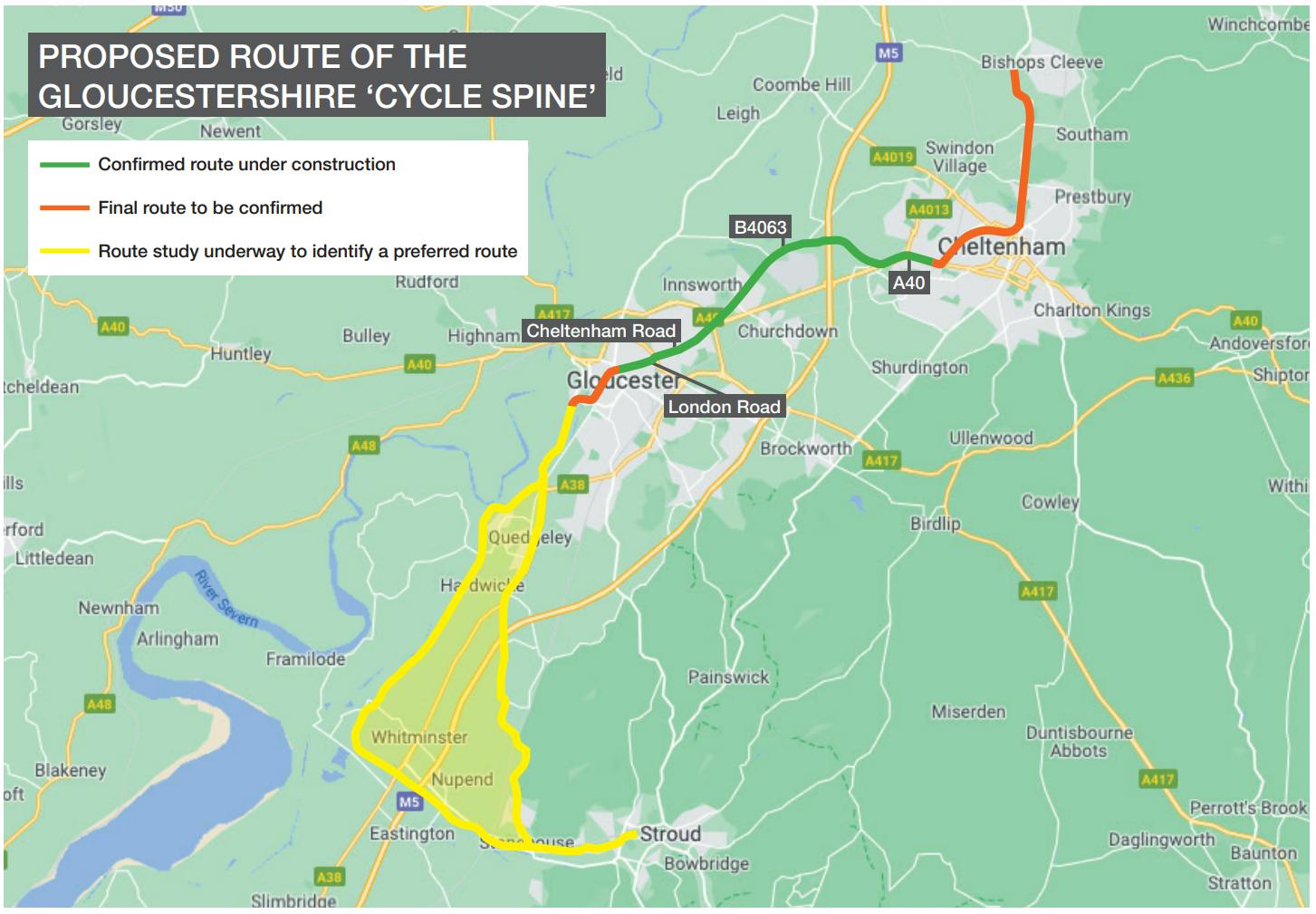Cycle Spine - Gloucester City Centre
Consultation has concluded.

Background
This scheme through Gloucester City Centre is part of the wider ambition for a Gloucestershire cycle spine, extending across the county from Stroud in the south to Bishop’s Cleeve in the north. It will contribute to a significant cycling and walking network across the county, improving quality and connectivity.
The scheme will provide full access to the 26-mile cycle spine from London Road to Southgate Street. It will connect to the docks in the south, a former industrial area which has transformed into a thriving and dynamic mixed community of businesses, visitors and residents. In the north, it will link to the B4063 Gloucester to Cheltenham cycle scheme at London Road.
The scheme will support a Greener Gloucestershire, help reduce carbon emissions, supporting improvements to public health and making it easier for people to cycle and walk to work, homes and transport hubs.
Overview

The scheme proposals include:
- Construction of a critical link of the Gloucestershire Cycle Spine.
- Segregated cycle tracks where traffic speed and flows are higher.
- On street cycle provision elsewhere where traffic flows are low.
- Improvements for cyclists and pedestrians at (and adjacent to) junctions and roundabouts, including new and improved crossing points.
- Improvements at Kimbrose triangle including formalised crossing points and new kerbs.
- Place making improvements through the pedestrianised gated streets.
- Reassigning parking spaces on Northgate and Southgate Street.
Route
The route runs from London Road through Northgate Street, Southgate Street up to Saint Ann Way junction, including Llanthony Road. It covers approximately 2 km (1.2 miles) in length.
The scheme is split into the following sections:
Section 1 – London Road and Black Dog Way
Two single direction segregated cycle tracks and straight, segregated crossings at Black Dog Way / London Road junction.
Section 2 – Northgate Street to Parliament Street
On-carriageway cycling where traffic speed and flows are low between the bus gate at Black Dog Way and The Oxbode. This will also tie in with the major works for currently underway at the former Debenhams by University of Gloucestershire and the Forum Development.
Cyclist and pedestrian shared area through sections of Northgate and Southgate Streets.
Section 3 – Parliament Street to St Ann Way
Improvements to Kimbrose Triangle including a formal crossing and new kerbs. Segregated two-way cycle track on west side of road. New pedestrian crossings and footway improvements
Section 4 – Llanthony Road to Spa Road
On-carriageway cycling over swing bridge and new two-way cycle track to link to A430 Llanthony Road.
Benefits
Accessibility
The new cycle scheme will be accessible to all by providing high quality access through the city streets making it shortest and most direct route for both cyclists and pedestrians. It will provide a continuous route for cyclists making cycling and sustainable travel more appealing, encouraging less reliance on car use.
Connectivity
Connecting people and places – The cycleway will create active travel links to Gloucester Docks, Gloucester’s Transport Hub, Railway Station and Gloucestershire Royal Hospital. It will also provide link for students to Gloucestershire College (at the docks), and towards the University at Oxstalls and to schools. The proposed route It will also connect to the B4063 cycleway currently under construction between Gloucester and Cheltenham and will be a key element or the wider Gloucestershire Cycle Spine between Stroud and Bishop’s Cleeve.
Safety
The scheme seeks to address known existing safety concerns for all road users. This includes the accident ‘hot spot’ along Southgate Street which has involved accidents with cyclists and pedestrians.
Environmental
The scheme will improve facilities for pedestrians, cyclists, and other non-motorised users and will help reduce greenhouse gas emissions and air pollution by replacing short, local car trips, contributing to CO2 reductions, and improving air quality.
Health and wellbeing
The Cycleway will improve physical and mental well-being by reducing stress, enhancing mood, promote healthy aging and the prevention of chronic diseases. Cycling is also shown to promote social interaction and community cohesion by creating opportunities for people to meet, talk and participate in local activities.
Placemaking
An improved sense of place and identity. Making the centre of Gloucester a more pleasant and attractive environment for people. Creating enhanced liveable and attractive human-scale urban spaces, reducing noise, stress and improving safety.
Saving time and money
Reducing the reliance on cars and car ownership. Saving money on maintenance, fuel and parking, as well as avoiding traffic congestion and delays.
 Source – Cycling and Walking Investment Strategy, Department for Transport (2018)
Source – Cycling and Walking Investment Strategy, Department for Transport (2018)The survey can also be made available as a hard copy via post, please contact majorprojects@gloucestershire.gov.uk or telephone 08000-514514.
The survey closes on Monday 7 August.






